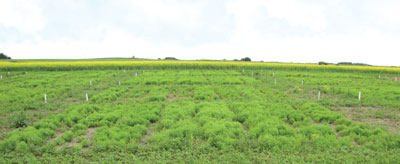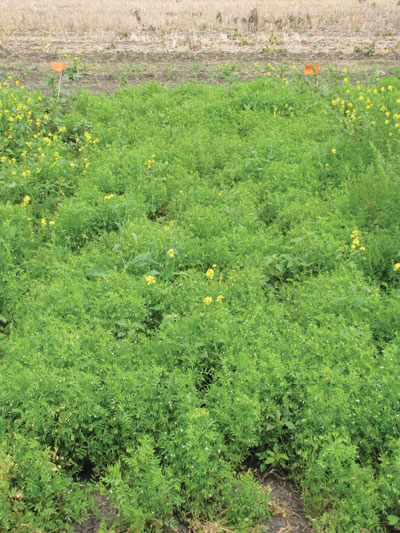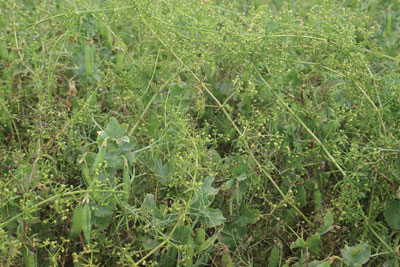
Features
Agronomy
Pulses
Controlling herbicide- resistant weeds in pulses
The glory days of new herbicide registrations and discoveries of new modes of action are likely over.
November 21, 2011 By Bruce Barker
The glory days of new herbicide registrations and discoveries of new modes of action are likely over. Now, finding new ways of controlling resistant weeds is a tough slog. Just ask weed scientist Eric Johnson.
 |
|
| Screening for lentil variety tolerance to Group 14 herbicides at the University of Saskatchewan. Photo courtesy of Ken Sapsford.
|
“There were 10 new modes of action registered in Canada in the 1960s and 1970s. That slowed to six in the 1980s, and then we went a full decade without any new modes of action. It is somewhat sobering to see that there aren’t a lot of solutions on the horizon,” says Johnson, who works at Agriculture and Agri-Food Canada at Scott, Saskatchewan.
 |
|
| Screening herbicides is showing some promise for Group 2 resistant weed control. Photo courtesy of Ken Sapsford.
|
Group 2 resistance has become especially problematic in pulses, where heavy reliance on Group 2 herbicides and lack of herbicide rotations has quickly led to Group 2 resistant broadleaf weeds. All kochia in Western Canada is likely resistant to Group 2 herbicides and is a problem in both pea and lentil crops. Group 2 resistant cleavers is becoming a problem in the Parkland in peas. In lentils, Group 2 resistant wild mustard has become a problem – no doubt exacerbated by the off-label use of a one-half rate of Pursuit.
“The loss of effectiveness of Group 2 has reduced the utility of Clearfield lentils. That is frustrating since a lot of research went into developing the technology,” says Johnson.
Other Group 2 resistant weeds on the radar screen include spiny annual sow thistle, chickweed and red root pigweed.
To look for solutions for Group 2 resistance in pulses, the provincial pulse growers associations in Alberta, Saskatchewan and Manitoba partnered with Agriculture and Agri-Food Canada to set up a Pulse Science Cluster to co-ordinate and fund research. The three-year project is also looking at alternative ways to manage Group 1 resistant grassy weeds in pulses. At the University of Saskatchewan, Ken Sapsford says they also have a five-year contract with the Saskatchewan Pulse Growers to conduct work on all areas of weed control in pulse crops. This includes controlling herbicide-resistant weeds, screening new herbicides, generating data for registration, developing recropping guidelines for residual herbicides and working with pulse crop breeders to improve pulse tolerance to herbicides.
Johnson, Sapsford, and Hugh Beckie at AAFC Saskatoon have been screening active ingredients with alternative modes of action as part of the Pulse Science Cluster research. Midway through the project, there are some glimmers and some failures.
“I never used to talk about the failures, but it is important to talk about those as well. It helps give a sense of how difficult it is to find new solutions and underscores the need to manage our existing chemistries better,” explains Johnson.
The duds
One such failure for managing Group 2 broadleaf weeds was linuron herbicide. It is an older, Group 7 herbicide registered for broadleaf weed control in other crops. In the US, it is registered for control of prickly lettuce in lentil. However, Johnson found that at the rates necessary to control wild mustard, the cost would be too high, and crop tolerance was compromised.
Another failure was an herbicide called propisochlor, a Group 15 product. Johnson couldn’t get acceptable weed control at acceptable rates.
Some promise
Sulfentrazone, a Group 14 product registered as Authority, is also being further investigated. Authority is registered on peas, chickpeas, sunflowers and flax for control of kochia, lamb’s quarters, redroot pigweed and wild buckwheat. Johnson screened it for control of cleavers and says there is some potential, but found that Authority did not provide good cleavers control on soils with organic matter over five percent – which excludes it from the northern parkland areas where cleavers is typically a problem in peas.
Sapsford says that his research saw similar results. At a 2x rate of Authority, he only saw 40 percent control of cleavers. On Dark Brown and Grey soils with 3 to 4.5 percent organic matter, he saw excellent control of cleavers in peas.
“It doesn’t work on Black soils with higher organic matter,” says Sapsford.
Another Group 15 product, pyroxasulfone was screened for broadleaf weed control, without much progress. Johnson is now looking at it for grassy weed control in pulses. It is soil applied and has shown activity on wild oats.
“Pyroxasulfone could provide another mode of action for wild oats, and we are also looking to see if it could be used as an alternative to Group 1 herbicides. There may be some potential for cleavers control as well, but that seems soil dependent and we don’t yet know the rates that would be needed,” explains Johnson.
He says that crop tolerance looks good but more research is required to improve consistency of control, which has ranged from 30 to over 90 percent. They are also looking at using it in combination with sulfentrazone.
Sapsford says pyroxasulfone also showed good activity on Group 2 resistant chickweed.
Another chemistry under investigation is the Group 14 active ingredient fluthiacet-methyl. It is being screened in combination with Sencor and Solo herbicides to provide control of kochia and wild mustard in lentils. It is showing promise as well, but crop tolerance still needs work.
The researchers are also working with plant breeders to investigate the tolerance of lentils to sulfentrazone. Some lentil germplasm has shown higher tolerance to sulfentrazone than others. Plant breeders are screening the germplasm to see if they can find higher tolerance. It may not lead to sulfentrazone being registered on lentils, but may reduce the recropping guidelines from 36 months to 12 months.
“We are continuing to screen what we can find. There are not a lot of herbicides to look at,” says Johnson.
Cleavers control in peas
Weed scientist Eric Johnson says that with cleavers in peas, Viper herbicide has provided reasonably good results in their experiments. Viper is registered for cleavers suppression. He says that timing is key, and to try to hit cleavers with Viper when they are small. “Viper is a product that is giving pretty good control if you go early. If you are looking for something with a little more kick, it might help,” explains Johnson. |
